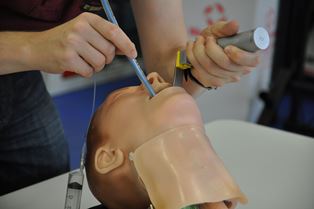Steerable device helps insertion of emergency breathing tube
19 December 2014
Researchers at Nottingham Trent University and Nottingham University Hospitals NHS Trust have developed a low-cost steerable device using used smart materials to help doctors insert a life-saving breathing tube into a patient’s windpipe in emergency situations.
The steerable endotracheal bougie is designed to improve the way that doctors insert endotracheal tubes into patients who are in intensive care or under a general anaesthetic.
A bougie is a long, flexible rod which doctors insert into a patient’s airway to establish a route for the tube to be guided over. Existing models have to be routinely removed and reshaped while navigating a patient’s windpipe, which can lead to delays. In some cases it isn’t possible to insert a breathing tube at all.

The prototype bougie being used to insert a
breathing tube
More than a million of such procedures are carried out in the UK each year, but up to 11% of patients have an airway which is difficult to navigate with a breathing tube, which can leave them at risk of reduced blood-oxygen levels and potential brain damage.
“What we’ve developed through the use of smart materials is a steerable bougie tip which can be inserted quickly and with a much greater chance of success,” said Professor Philip Breedon, a professor of smart technologies at the School of Architecture, Design and the Built Environment at Nottingham Trent University.
“The tip can move by more than 120 degrees within a second, which is more than adequate for the clinician’s needs. And it can be fully controlled by one person, which is ideal for the circumstances of an emergency.”
The bougie uses Flexinol, a nickel-titanium shape memory alloy which is used as an artificial muscle. Two Felxinol wires are situated in the disposable bougie casing and when heat is applied to one of the wires via an electric current it shortens, enabling the flexible tip to be steered via a detachable controller.
Luke Siena, a postgraduate researcher at the School of Architecture, Design and the Built Environment and member of the research team, said, “We think that this invention has real potential to fill a unique and sizeable gap in the market. The design is fully compatible with the endotracheal tubes currently used by the NHS and we expect it will be cost-effective to manufacture.
“Our ultimate aim is for it to be used routinely by clinicians and help improve the way that patients are dealt with in what can be very difficult situations for medical staff.”